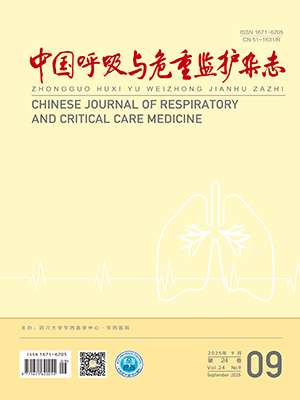| 1. |
McCabe C, Dimopoulos K, Pitcher A, et al. Chronic thromboembolic disease following pulmonary embolism: time for a fresh look at old clot. Eur Respir J, 2020, 55(4): 1901934.
|
| 2. |
谢万木. 慢性肺血栓栓塞症与慢性血栓栓塞性肺动脉高压. 中国实用内科杂志, 2021, 41(6): 508-511.
|
| 3. |
Lewczuk J, Piszko P, Jagas J, et al. Prognostic factors in medically treated patients with chronic pulmonary embolism. Chest, 2001, 119(3): 818-823.
|
| 4. |
Maron BA, Hess E, Maddox TM, et al. Association of borderline pulmonary hypertension with mortality and hospitalization in a large patient cohort: Insights From the Veterans Affairs Clinical Assessment, Reporting, and Tracking Program. Circulation, 2016, 133(13): 1240-1248.
|
| 5. |
Fabyan KD, Holley AB. Postpulmonary embolism syndrome. Curr Opin Pulm Med, 2021, 27(5): 335-341.
|
| 6. |
孙兴国. 整体整合生理学医学新理论体系: 人体功能一体化自主调控. 中国循环杂志, 2013, 28(2): 88-92.
|
| 7. |
陈奕霖, 张婷婷, 陈豫钦, 等. 慢性血栓栓塞性肺动脉高压发病机制研究进展. 中华结核和呼吸杂志, 2022, 45(3): 304-308.
|
| 8. |
Held M, Hesse A, Gött F, et al. A symptom-related monitoring program following pulmonary embolism for the early detection of CTEPH: a prospective observational registry study. BMC Pulm Med, 2014, 14: 141.
|
| 9. |
Wiedenroth CB, Olsson KM, Guth S, et al. Balloon pulmonary angioplasty for inoperable patients with chronic thromboembolic disease. Pulm Circ, 2018, 8(1): 2045893217753122.
|
| 10. |
Kim NH, Delcroix M, Jais X, et al. Chronic thromboembolic pulmonary hypertension. Eur Respir J, 2019, 53(1): 1801915.
|
| 11. |
Lang IM, Campean IA, Sadushi-Kolici R, et al. Chronic thromboembolic disease and chronic thromboembolic pulmonary hypertension. Clin Chest Med, 2021, 42(1): 81-90.
|
| 12. |
Papamatheakis DG, Poch DS, Fernandes TM, et al. Chronic Thromboembolic Pulmonary Hypertension: JACC Focus Seminar. J Am Coll Cardiol, 2020, 76(18): 2155-2169.
|
| 13. |
刘格婧, 李爱莉, 翟亚楠, 等. 慢性血栓栓塞性肺动脉高压患者左心室功能改变及肺动脉内膜剥脱术后恢复情况. 中华超声影像学杂志, 2022, 31(3): 245-251.
|
| 14. |
Held M, Kolb P, Grün M, et al. Functional characterization of patients with chronic thromboembolic disease. Respiration, 2016, 91(6): 503-509.
|
| 15. |
C Robertson L, E Oates K, J Fletcher A, et al. The association of six-minute walk work and other clinical measures to cardiopulmonary exercise test parameters in pulmonary vascular disease. Pulm Circ, 2021, 11(4): 1-12.
|
| 16. |
孙兴国, 王桂芝, 吕婧, 等. 摄氧和二氧化碳排出通气效率是反映循环功能的指标. 中华心血管病杂志, 2014, 42(12): 1022-1028.
|
| 17. |
Claeys M, Claessen G, La Gerche A, et al. Impaired cardiac reserve and abnormal vascular load limit exercise capacity in chronic thromboembolic disease. JACC Cardiovasc Imaging, 2019, 12(8 Pt 1): 1444-1456.
|
| 18. |
Galiè N, Hoeper MM, Humbert M, et al. Guidelines for the Diagnosis and Treatment of Pulmonary Hypertension: the Task Force for the Diagnosis and Treatment of Pulmonary Hypertension of the European Society of Cardiology (ESC) and the European Respiratory Society (ERS), endorsed by the International Society of Heart and Lung Transplantation (ISHLT). Eur Heart J, 2009, 30(20): 2493-2537.
|
| 19. |
Held M, Grün M, Holl R, et al. Cardiopulmonary exercise testing to detect chronic thromboembolic pulmonary hypertension in patients with normal echocardiography. Respiration, 2014, 87(5): 379-387.
|
| 20. |
唐毅, 罗勤, 柳志红, 等. 摄氧效率斜率预测特发性肺动脉高压预后. 中国循环杂志, 2017, 32(4): 367-371.
|
| 21. |
王林宣, 郭健, 杨文兰, 等. 不同类型肺动脉高压患者运动耐量的研究. 国际呼吸杂志, 2015, 35(24): 1878-1882.
|




